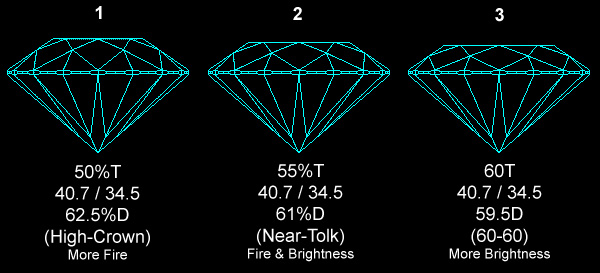strmrdr
Super_Ideal_Rock
- Joined
- Nov 1, 2003
- Messages
- 23,295
This is my personal opinion mixed in with some facts to open a discussion on this subject.
We often hear that a diamond don''t face up like it should or has bad spread.
How does one define bad spread?
You can compare it to another combination of proportions as is currently done.
My opinion is that is not the correct way to do it.
Trading spread for a different look or a different performance curve is a legitimate thing to do if it achives the effect you want and find beautiful.
The correct way of doing it in my opinion is looking at what the diamond is giving in performance and looks then balance that against the spread.
But putting this in a cut grading system is hard which is why the current system is in use.
I think that the current system is keeping a lot of beautiful combinations off the market along with yield from the rough.
Yield can be dealt with as it is today by picking the best shape for any given rough when cutting it and high yield cuts are possible in this category.
The in my opinion artificial spread criteria is much harder to deal with and move beyond.
I envision a future where diamonds may be as custom as settings are today and designer diamonds become a reality with diamond designers working with setting designers and cutters as a team.
Instead of heading in that direction roadblocks are being put in the way like spread specifications.
This is also the huge downside of cut grading which spread is a part of and it puts the brakes on innovation.
What about performance grading?
Performance grading is a great advance and I am all for improved cut quality but forcing all variations into one mold with proportion limits is not the way to do it in my opinion.
Discuss :}
We often hear that a diamond don''t face up like it should or has bad spread.
How does one define bad spread?
You can compare it to another combination of proportions as is currently done.
My opinion is that is not the correct way to do it.
Trading spread for a different look or a different performance curve is a legitimate thing to do if it achives the effect you want and find beautiful.
The correct way of doing it in my opinion is looking at what the diamond is giving in performance and looks then balance that against the spread.
But putting this in a cut grading system is hard which is why the current system is in use.
I think that the current system is keeping a lot of beautiful combinations off the market along with yield from the rough.
Yield can be dealt with as it is today by picking the best shape for any given rough when cutting it and high yield cuts are possible in this category.
The in my opinion artificial spread criteria is much harder to deal with and move beyond.
I envision a future where diamonds may be as custom as settings are today and designer diamonds become a reality with diamond designers working with setting designers and cutters as a team.
Instead of heading in that direction roadblocks are being put in the way like spread specifications.
This is also the huge downside of cut grading which spread is a part of and it puts the brakes on innovation.
What about performance grading?
Performance grading is a great advance and I am all for improved cut quality but forcing all variations into one mold with proportion limits is not the way to do it in my opinion.
Discuss :}





300x240.png)